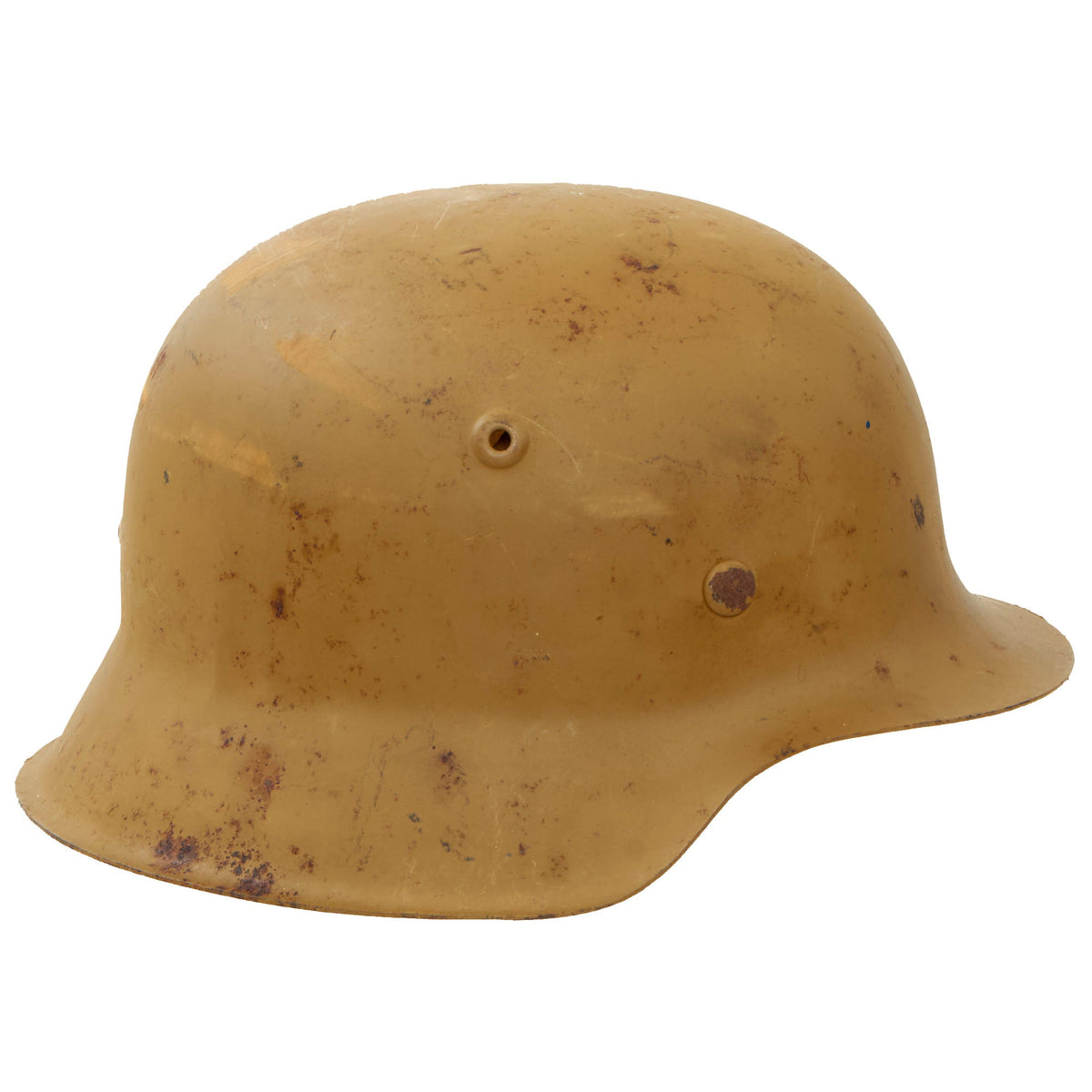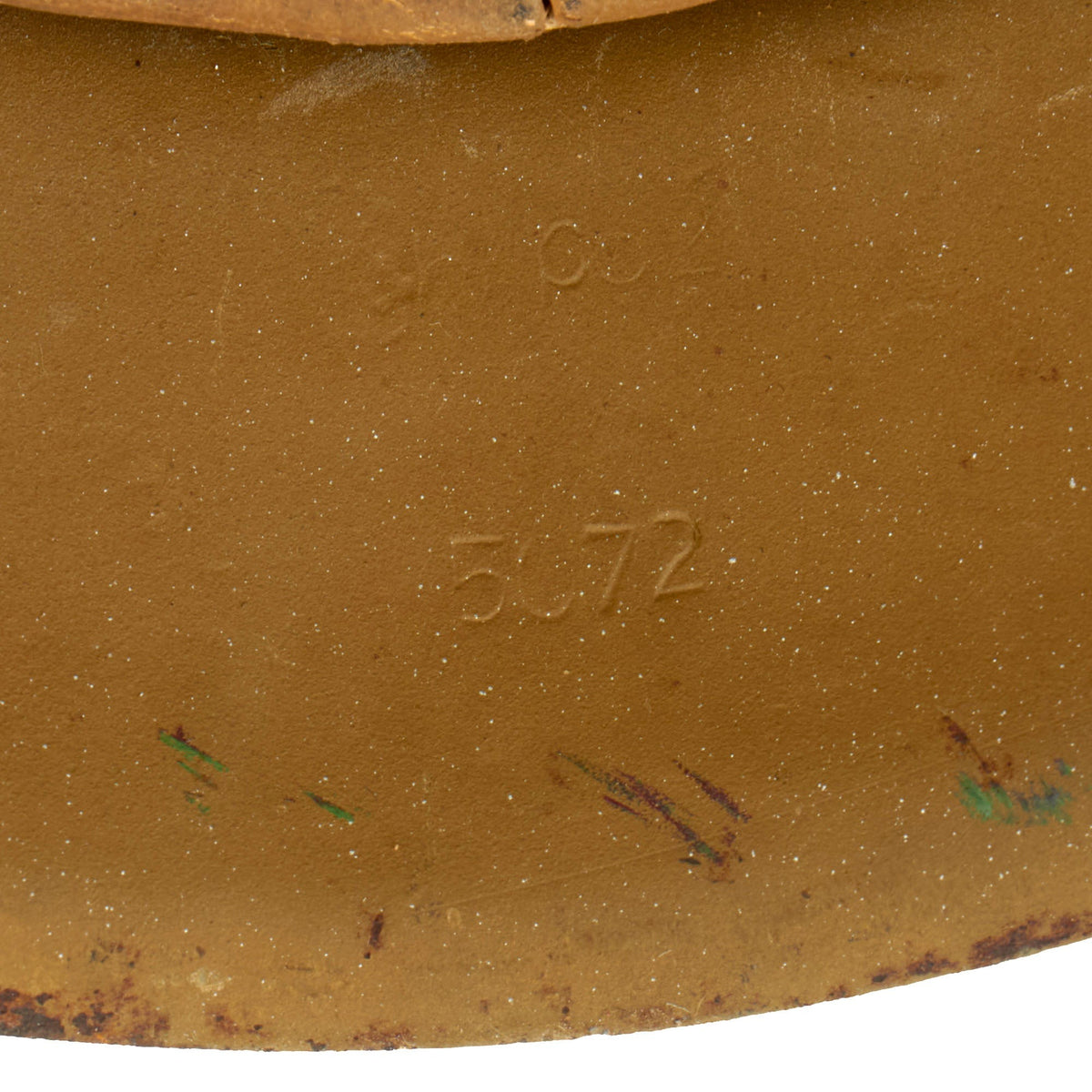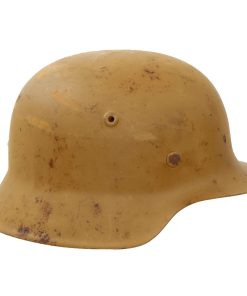Original German WWII M42 Unissued Army Heer “Ordnance Tan” Painted Helmet with 55cm Liner & 1944 Dated Chinstrap – stamped hkp62 Original Items
$ 895,00 $ 223,75
Original Item: Only One Available. Here we have a very interesting unissued example of a German Model 42 Steel helmet, as issued to the Wehrmacht Heer (army). Unlike most made during WWII, this example was not painted Feldgrau (Field Gray) at the factory, but instead “Ordnance Tan”, very similar to the Dunkelgelb (dark yellow) paint used for the Tropical Campaigns in North Africa. It shows wear from transport, handling, and storage, but no real evidence of having been issued in the field.
We have heard that this is one of a substantial amount of these helmets found after the end of the war in a depot. It is believed that they were either to be destined for offensives in the Southern Caucuses or Mediterranean, which had terrain similar to much of the North African coast. It shows wear to the shell from storage and transportation, mostly around the bottom of the helmet. There are no decals affixed, presumable as they were to be applied when they were issued.
The shell is stamped with hkp62 on the rear skirt above heat lot 5072, indicating that Sächsische Emaillier und Stanzwerke A.G. of Lauter, Germany manufactured it in size 62. Towards the end of the war, the SE marking was discontinued in favor of the three letter code hkp. Size 62 is a nice smaller size that can accommodate liners from 54cm to 55cm or US 6 3/4 to 6 7/8.
All three liner retaining pins are intact, with the original paint retained to a varying degree. The interior of the helmet still has the original M31 leather liner present, which is in excellent condition. It is still tan in color, and shows little to no sign of use or wear, though the top tie string is missing. The late war issue galvanized steel liner band is marked on the left outer side with 62 nA / 55, indicating that the liner is a size 55, intended for a 62 shell. This is hard to read however, due to “white rust” zinc oxidation present on most of the band, which also has made the original maker markings illegible.
The attached chin strap has the correct steel hardware, which shows oxidation from age and exposure. There is little sign of wear, though the leather itself has dried and become stiff over the decades. It is marked on the long end with a faded maker stamp and a 44 date.
Overall a lovely unissued M42 Heer Army helmet in “Ordnance Tan” with an interesting history and a great look! M42 helmets of this quality are always the hardest to find on the market. This is an item that will only continue to appreciate in value over time.
The first “modern” steel helmets were introduced by the French army in early 1915 and were shortly followed by the British army later that year. With plans on the drawing board, experimental helmets in the field, (“Gaede” helmet), and some captured French and British helmets the German army began tests for their own steel helmet at the Kummersdorf Proving Grounds in November, and in the field in December 1915. An acceptable pattern was developed and approved and production began at Eisen-und Hüttenwerke, AG Thale/Harz, (Iron and Foundry Works), in the spring of 1916.
These first modern M16 helmets evolved into the M18 helmets by the end of WWI. The M16 and M18 helmets remained in usage through-out the Weimar Reichswehr, (National Defence Force, Circa 1919-1933), era and on into the early years of the Third Reich until the development of the smaller, lighter M35 style helmet in June 1935.
In 1934 tests began on an improved Stahlhelm, whose design was a development of World War I models. The Eisenhüttenwerke company of Thale carried out prototype design and testing, with Dr. Friedrich Schwerd once again taking a hand.
The new helmet was pressed from sheets of molybdenum steel in several stages. The size of the flared visor and skirt was reduced, and the large projecting lugs for the obsolete armor shield were eliminated. The ventilator holes were retained, but were set in smaller hollow rivets mounted to the helmet’s shell. The edges of the shell were rolled over, creating a smooth edge along the helmet. Finally, a completely new leather suspension, or liner, was incorporated that greatly improved the helmet’s safety, adjustability, and comfort for each wearer. These improvements made the new M1935 helmet lighter, more compact, and more comfortable to wear than the previous designs.
The Army’s Supreme Command officially accepted the new helmet on June 25, 1935 and it was intended to replace all other helmets in service.
The M1935 design was slightly modified in 1940 to simplify its construction, the manufacturing process now incorporating more automated stamping methods. The principal change was to stamp the ventilator hole mounts directly onto the shell, rather than utilizing separate fittings. In other respects, the M1940 helmet was identical to the M1935. The Germans still referred to the M1940 as the M1935, while the M1940 designation were given by collectors.
The last wartime upgrade to the standard helmet took place on 6 July 1942 at the request of the Army High Command. The rolled edge found on M1935 and M1940 helmets was discontinued as a measure of economy. On 1 August 1942 the first M1942 helmets were placed into production, and this was the model produced until late in the war, when most factories were captured or stood idle due to material shortages.
Fast Shipping with Professional Packaging
Thanks to our longstanding association with UPS FedEx DHL, and other major international carriers, we are able to provide a range of shipping options. Our warehouse staff is expertly trained and will wrap your products according to our exact and precise specifications. Prior to shipping, your goods will be thoroughly examined and securely secured. We ship to thousands clients each day across multiple countries. This shows how we're dedicated to be the largest retailer on the internet. Warehouses and distribution centres can be located throughout Europe as well as the USA.
Note: Orders with more than one item will be assigned a processing date depending on the item.
Before shipping before shipping, we'll conduct a thorough inspection of the items you have ordered. Today, the majority of orders will be delivered within 48 hours. The delivery time will be between 3-7 days.
Returns
The stock is dynamic and we cannot completely manage it because multiple stakeholders are involved, including our factory and warehouse. So the actual stock may alter at any time. It's possible that you may not receive your order once the order has been made.
Our policy is valid for a period of 30 days. If you don't receive the product within 30 days, we are not able to issue a refund or an exchange.
You can only return an item if it is unused and in the same state as the day you received it. You must have the item in its original packaging.
Related products
Uncategorized
Uncategorized
Uncategorized
Uncategorized
Uncategorized
Uncategorized
Armored Burgonet Helmet & Polearm from Scottish Castle Leith Hall Circa 1700 Original Items
Uncategorized
Uncategorized
Uncategorized
Uncategorized
Uncategorized
Australian WWII Owen MK1 Machine Carbine SMG Custom Fabricated Replica with Sling Original Items
Uncategorized
Uncategorized
Uncategorized
Uncategorized













































































